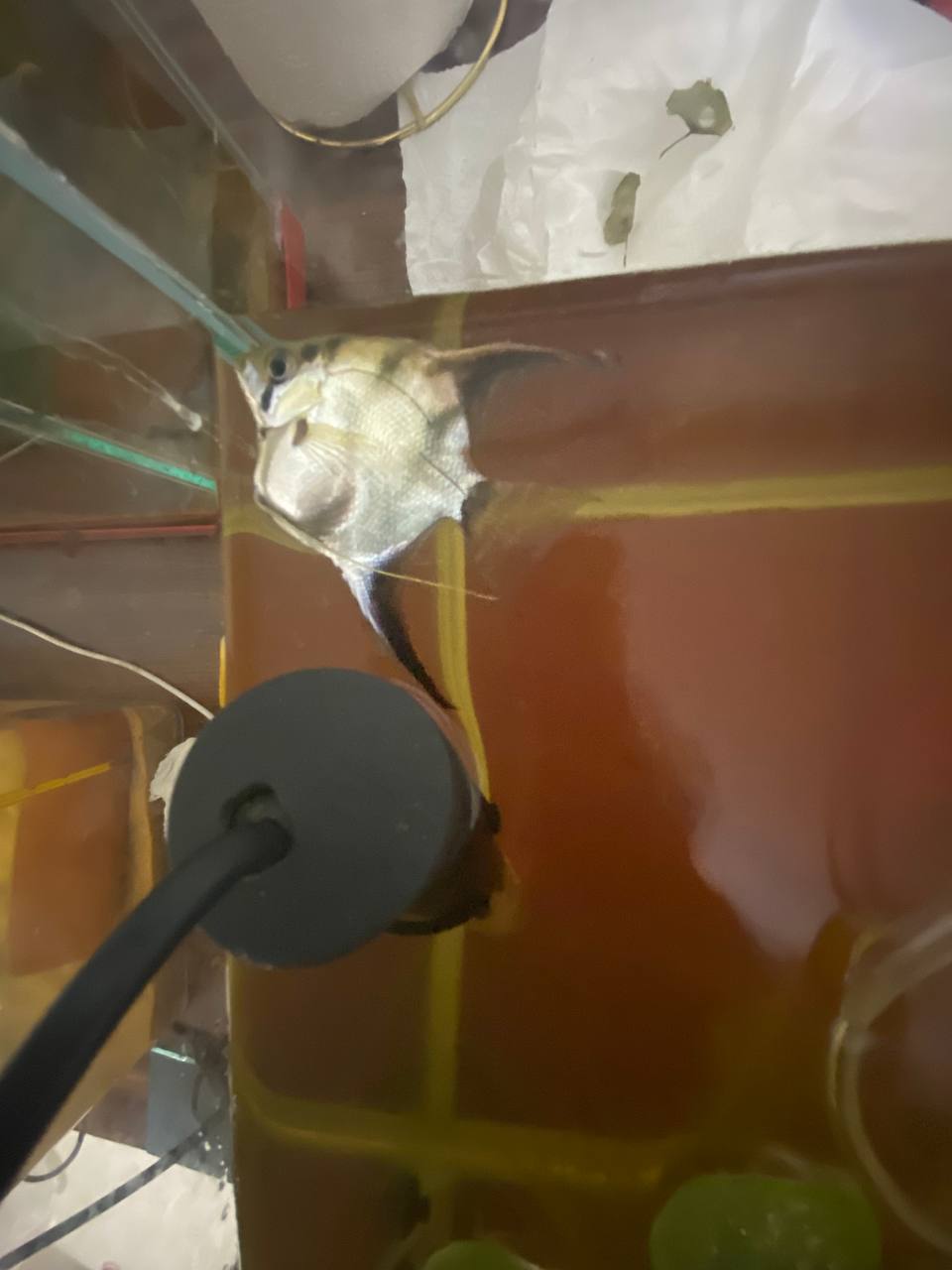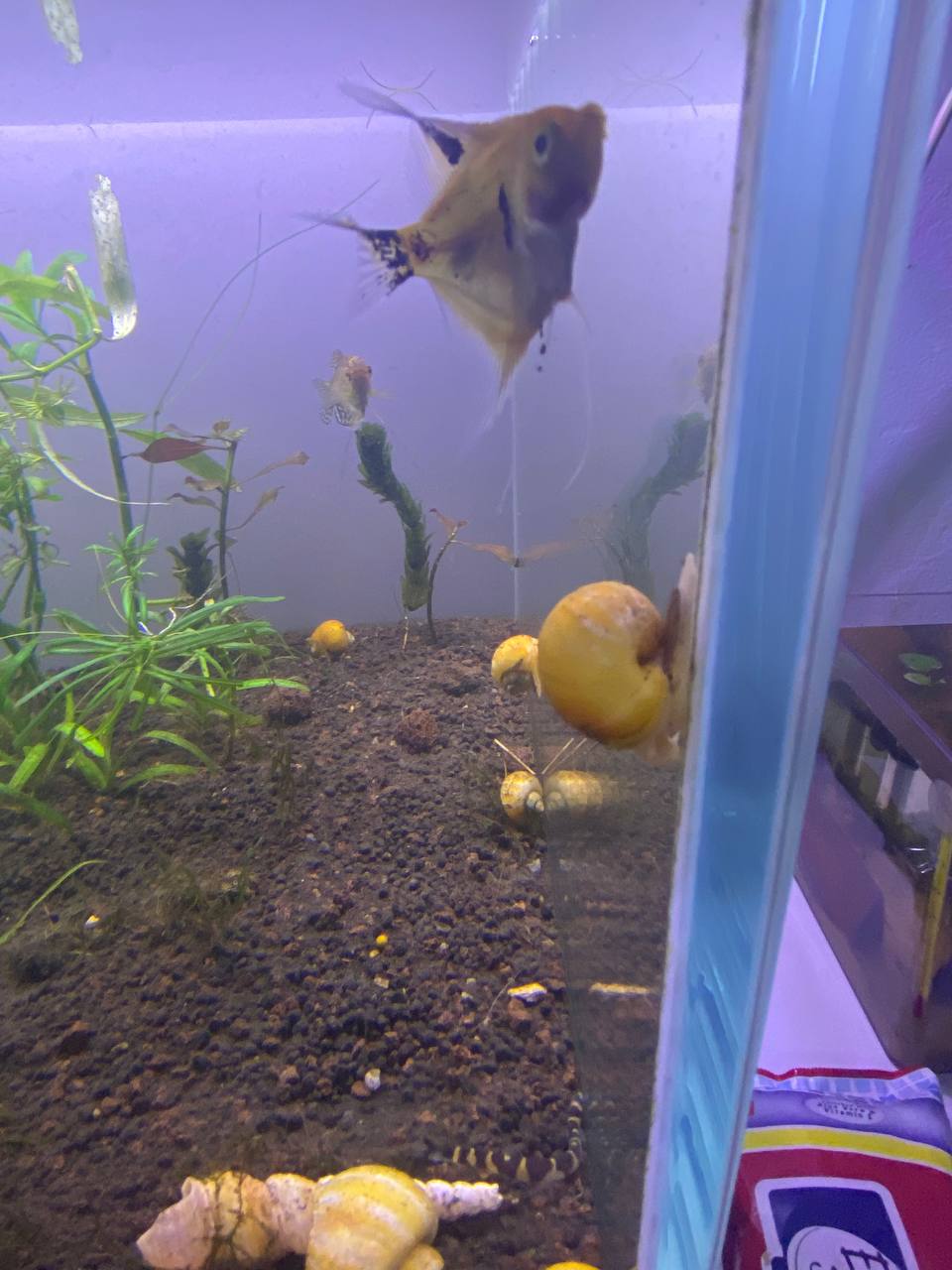You are using an out of date browser. It may not display this or other websites correctly.
You should upgrade or use an alternative browser.
You should upgrade or use an alternative browser.
My angelfish has a bloated stomach help
- Thread starter elfeves
- Start date
The friendliest place on the web for anyone with an interest in aquariums or fish keeping!
If you have answers, please help by responding to the unanswered posts.
If you have answers, please help by responding to the unanswered posts.
Andy Sager
Aquarium Advice Addict
Sounds like the fish is constipated and now bloated. What kind of " Bait" were you feeding him/her? If possible, can you post a picture of the fish with a close up of the abdominal area.
Andy Sager
Aquarium Advice Addict
From the pic it appears to be a smaller fish which eliminates it being eggs. The shape makes it look like it's from over eating. If your gourami died with a swollen belly, it's time to switch your foods. Angels should be fed a different diet than a Betta so you need to get a food more designed for mixed tropical fish. Whether that be a flake or pellet or frozen diet, it needs to have a variety of ingredients. You might want to look into Dr Bassleer foods, Omega one flakes, Frozen bloodworms or brine shrimp, etc. You need to give your fish a protein and a vegetable or a food for roughage to help them poop. In my Angelfish hatchery, I fed 3 times per day. Morning: Basic flake food. Midday: High protein food ( Black worms, Krill flakes, Shrimp flakes) Last feeding: ROUGHAGE!!!! Frozen or live brine shrimp or algae flakes or Bloodworms or Mysis shrimp, etc. ( Anything with a shell that they will pass through. ) You also want to limit the amount of food to what the fish can eat in 2 minutes. No more. Feeding your fish until it's stuffed like this is not good for the fish.
As for a remedy, no more feeding until the swelling goes down. That should happen after a nice " dump". You can help that along with doing Epsom Salt baths or adding Epsom Salt to the tank. As a bath in a separate container, add 1 tablespoon of Epsom salt to 1 gal of tank water. For the aquarium, add 1 tablespoon per 3 gallons. (In the aquarium, it's best to add the Epsom salt over some time so as not to shock the system. Dissolve the required amount in a separate container and add to aquarium in intervals )
Leave the fish in the bath for 10-15 minutes. ( If the fish shows signs of stress, remove immediately and place back into the aquarium. )
Things to note: Epsom salt is not like aquarium salt. It is actually Magnesium sulfate so not interchangeable with sodium based salts.
If you have fish that require soft water, do not use the Epsom salt in the aquarium and just do baths. You can repeat the baths 2 times per day.
Hope this helps.
As for a remedy, no more feeding until the swelling goes down. That should happen after a nice " dump". You can help that along with doing Epsom Salt baths or adding Epsom Salt to the tank. As a bath in a separate container, add 1 tablespoon of Epsom salt to 1 gal of tank water. For the aquarium, add 1 tablespoon per 3 gallons. (In the aquarium, it's best to add the Epsom salt over some time so as not to shock the system. Dissolve the required amount in a separate container and add to aquarium in intervals )
Leave the fish in the bath for 10-15 minutes. ( If the fish shows signs of stress, remove immediately and place back into the aquarium. )
Things to note: Epsom salt is not like aquarium salt. It is actually Magnesium sulfate so not interchangeable with sodium based salts.
If you have fish that require soft water, do not use the Epsom salt in the aquarium and just do baths. You can repeat the baths 2 times per day.
Hope this helps.
Andy Sager
Aquarium Advice Addict
Just saw these pics. The Gourami and Angel are having different issues. Dwarf Gouramis carry a virus which yours seems to be suffering from. It's not curable so euthanizing is best to prohibit any healthy fish from catching it by eating the dead contaminated fish. Since the fish died already, it's best not to replace with another dwarf gourami specie.
Colin_T
Aquarium Advice Addict
The gourami or whatever it is in one of the pictures is covered in excess mucous (the white stuff on its body). It's caused by poor water quality, chemicals in the water, or an external protozoan infection.
Test the water for ammonia, nitrite, nitrate and pH.
Wipe the inside of the glass down with a clean fish sponge. This removes the biofilm on the glass and the biofilm will contain lots of harmful bacteria, fungus, protozoans and various other microscopic life forms.
Do a 75% water change and gravel clean the substrate. The water change and gravel cleaning will reduce the number of disease organisms in the water and provide a cleaner environment for the fish to recover in. It also removes a lot of the gunk and this means any medication can work on treating the fish instead of being wasted killing the pathogens in the gunk.
Make sure any new water is free of chlorine/ chloramine before it is added to the tank.
Clean the filter if it hasn't been done in the last 2 weeks. However, if the filter is less than 6 weeks old, do not clean it. Wash the filter materials/ media in a bucket of tank water and re-use the media. Tip the bucket of dirty water on the garden/ lawn. Cleaning the filter means less gunk and cleaner water with fewer pathogens so any medication (if needed) will work more effectively on the fish.
Increase surface turbulence/ aeration to maximise the dissolved oxygen in the water.
Add some salt, (see directions below).
--------------------
SALT
You can add rock salt (often sold as aquarium salt), swimming pool salt, or any non iodised salt (sodium chloride) to the aquarium at the dose rate of 1 heaped tablespoon per 20 litres of water. If there is no improvement after 48 hours you can double that dose rate so there is 2 heaped tablespoons of salt per 20 litres.
Keep the salt level like this for at least 2 weeks but no longer than 4 weeks otherwise kidney damage can occur. Kidney damage is more likely to occur in fish from soft water (tetras, Corydoras, angelfish, Bettas & gouramis, loaches) that are exposed to high levels of salt for an extended period of time, and is not an issue with livebearers, rainbowfish or other salt tolerant species.
The salt will not affect the beneficial filter bacteria, fish, plants, shrimp or snails.
After you use salt and the fish have recovered, you do a 10% water change each day for a week using only fresh water that has been dechlorinated. Then do a 20% water change each day for a week. Then you can do bigger water changes after that. This dilutes the salt out of the tank slowly so it doesn't harm the fish.
If you do water changes while using salt, you need to treat the new water with salt before adding it to the tank. This will keep the salt level stable in the tank and minimise stress on the fish.
When you first add salt, add the salt to a small bucket of tank water and dissolve the salt. Then slowly pour the salt water into the tank near the filter outlet. Add the salt over a couple of minutes.
Test the water for ammonia, nitrite, nitrate and pH.
Wipe the inside of the glass down with a clean fish sponge. This removes the biofilm on the glass and the biofilm will contain lots of harmful bacteria, fungus, protozoans and various other microscopic life forms.
Do a 75% water change and gravel clean the substrate. The water change and gravel cleaning will reduce the number of disease organisms in the water and provide a cleaner environment for the fish to recover in. It also removes a lot of the gunk and this means any medication can work on treating the fish instead of being wasted killing the pathogens in the gunk.
Make sure any new water is free of chlorine/ chloramine before it is added to the tank.
Clean the filter if it hasn't been done in the last 2 weeks. However, if the filter is less than 6 weeks old, do not clean it. Wash the filter materials/ media in a bucket of tank water and re-use the media. Tip the bucket of dirty water on the garden/ lawn. Cleaning the filter means less gunk and cleaner water with fewer pathogens so any medication (if needed) will work more effectively on the fish.
Increase surface turbulence/ aeration to maximise the dissolved oxygen in the water.
Add some salt, (see directions below).
--------------------
SALT
You can add rock salt (often sold as aquarium salt), swimming pool salt, or any non iodised salt (sodium chloride) to the aquarium at the dose rate of 1 heaped tablespoon per 20 litres of water. If there is no improvement after 48 hours you can double that dose rate so there is 2 heaped tablespoons of salt per 20 litres.
Keep the salt level like this for at least 2 weeks but no longer than 4 weeks otherwise kidney damage can occur. Kidney damage is more likely to occur in fish from soft water (tetras, Corydoras, angelfish, Bettas & gouramis, loaches) that are exposed to high levels of salt for an extended period of time, and is not an issue with livebearers, rainbowfish or other salt tolerant species.
The salt will not affect the beneficial filter bacteria, fish, plants, shrimp or snails.
After you use salt and the fish have recovered, you do a 10% water change each day for a week using only fresh water that has been dechlorinated. Then do a 20% water change each day for a week. Then you can do bigger water changes after that. This dilutes the salt out of the tank slowly so it doesn't harm the fish.
If you do water changes while using salt, you need to treat the new water with salt before adding it to the tank. This will keep the salt level stable in the tank and minimise stress on the fish.
When you first add salt, add the salt to a small bucket of tank water and dissolve the salt. Then slowly pour the salt water into the tank near the filter outlet. Add the salt over a couple of minutes.
Colin_T
Aquarium Advice Addict
If fish have intestinal worms they can expel worm eggs when they go to the toilet. They can also expel internal protozoan parasites via their poop.
Andy Sager
Aquarium Advice Addict
That doesn't look like worm poo but as Colin stated, they can pass eggs through the feces. Worm poo is generally white and stringy. This fish looks like it's passing food in chunks which is a sign of an improper diet. A good diet will produce a solid colored "string". Keep in mind that snails can be intermediate hosts for a number of parasites. They don't kill the snails so you don't know if they have anything until it's on/in another fish.
How is the fish in post #3?
Similar threads
- Replies
- 10
- Views
- 796
- Replies
- 3
- Views
- 518
- Replies
- 10
- Views
- 2K
- Replies
- 10
- Views
- 1K
- Replies
- 7
- Views
- 535



